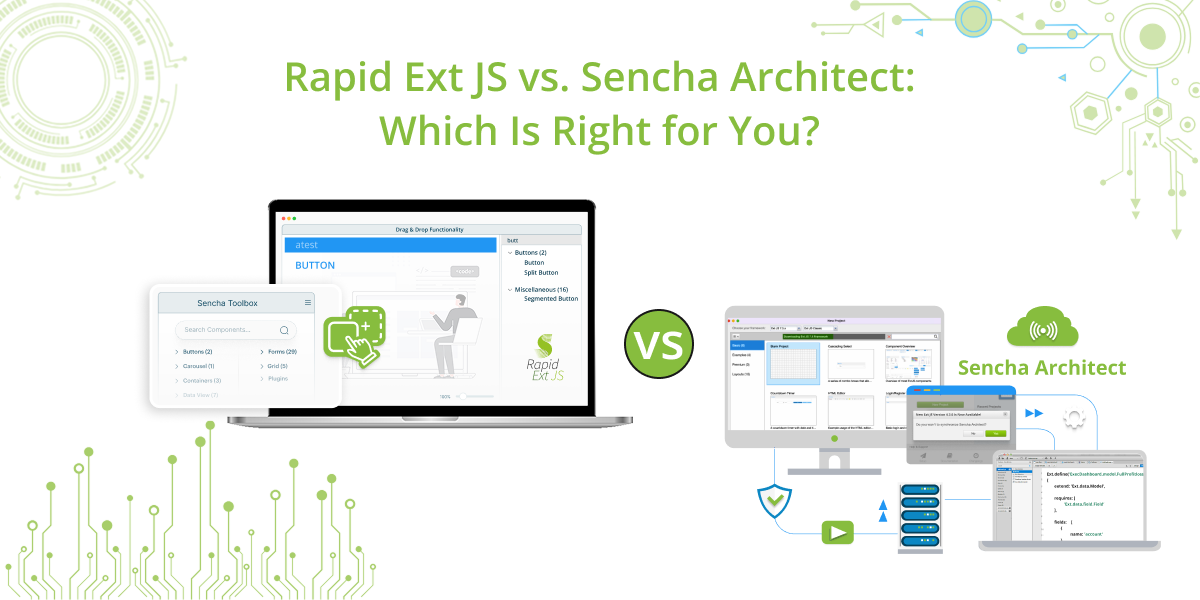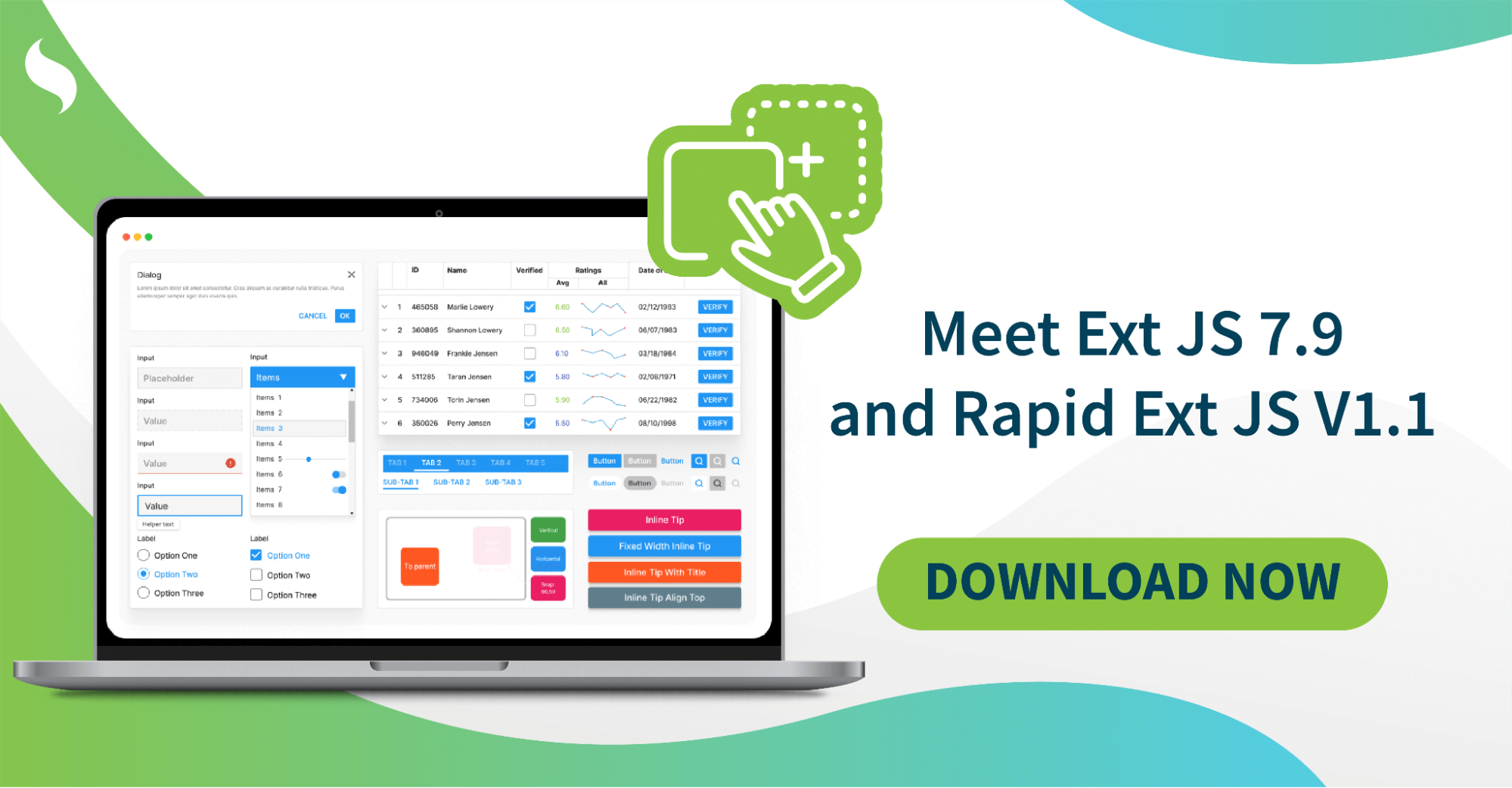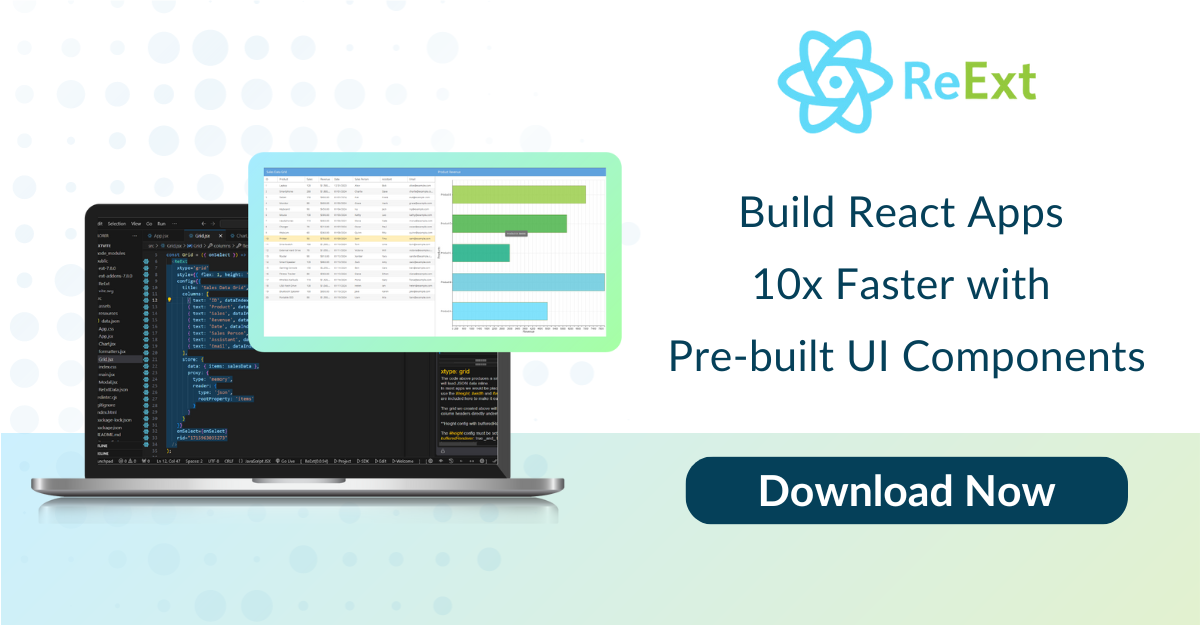Enterprise Ready React Data Grid | GRUI by Sencha
Enterprise-level React applications need to handle massive amounts of data. To achieve this, you need a sophisticated data grid solution. ReExt from Sencha provides one such solution. It delivers high performance for complex data operations.
Companies increasingly depend on data-heavy applications. Therefore, businesses must have a robust data grid. ReExt offers scalability, speed, and seamless React integration. These features make ReExt an efficient and powerful tool for building rich, responsive applications.
This blog will start by explaining what ReExt is and its key features. We will focus on why developers should consider it for React-specific solutions. Next, we will compare ReExt with other popular data grids. This will help you understand how it performs in custom environments. Finally, we will discuss the best practices for using ReExt in your projects.
If you are new to ReExt or planning to use it, this guide will provide the information you need. Let’s get started!

What is ReExt by Sencha?
ReExt by Sencha is a framework that combines React and Ext JS. It helps developers build powerful web applications by allowing them to leverage both technologies. With ReExt, developers can use Ext JS components in React apps.
Features
ReExt includes many important features. One key feature is the ability to embed Ext JS components into React applications. Developers can use templates for grids, charts, forms, and other UI elements. These components are customizable and optimized for performance.
The framework also supports data binding and state management. Data binding synchronizes the UI with underlying data. This helps developers create responsive applications. State management ensures smooth updates across the app. It simplifies handling complex states.
Benefits
ReExt speeds up application development. Developers can reuse Ext JS components, saving time. They use these components as common elements in user interfaces. Reusing them reduces development time and minimizes errors.
The framework is easy to use and has clear documentation. Developers can quickly start working with ReExt without much training. This makes it suitable for both advanced and novice developers.
Compatibility
ReExt works with all versions of React. It also supports Ext JS 7.x and higher. The framework is cross-platform and cross-browser compatible. It ensures that applications run smoothly on various devices and browsers.
Customization
ReExt allows full customization. Developers can modify components to meet their needs. The framework offers building blocks that enable developers to build apps progressively. This flexibility helps developers create unique solutions.

Why Choose ReExt to Build a React Application?
ReExt enhances React by integrating Ext JS. It allows developers to quickly create advanced UI components, allowing them to build applications fast while maintaining flexibility. Here are the key reasons why ReExt is ideal for React development.
1. Reusable Components
ReExt provides a large library of pre-designed, reusable components. These include grids, forms, charts, and navigation controls. Using these components greatly reduces development time. Developers can customize them instead of creating new ones. This makes projects simpler and ensures consistency across the app.
2. Fully Customizable
ReExt allows developers to fully customize its components. Developers are not limited to the pre-designed components. They can redesign, specify, and integrate components as needed. This level of flexibility means you can create a unique, user-friendly experience without limitations.
3. Compatibility
ReExt guarantees compatibility between React and Ext JS. This integration allows you to leverage both frameworks. You can ensure everything works well. ReExt is designed to integrate with other libraries and tools. It fits into your current approach easily. Whether you build a new application or modify an existing one, ReExt’s compatibility simplifies the process.
4. Performance
Performance is crucial for web applications. ReExt fine-tunes itself to deliver fast and responsive apps. The efficiency of Ext JS and the reactivity of React ensure that ReExt-powered applications remain lightweight. ReExt guarantees that large datasets and complex UIs won’t slow down performance. Good performance is essential for responsive UIs that handle touch and other inputs smoothly.
5. Continuous Updates & Support
ReExt provides regular updates and support. You won’t miss out on the latest features or bug fixes. ReExt offers tools for quick fixes or issues during development. You won’t face problems alone with ReExt. The framework provides continuous updates and improvements for your project.
The ReExt framework suits React developers perfectly. It allows the use of Ext JS within React, helping you develop modern UI components faster. You get flexibility and performance without compromise.
The high degree of customizability, reusable components, performance focus, and compatibility with other tools make ReExt a great fit for complex React applications. ReExt’s complete project management ensures that your project stays up-to-date with technology and optimization.

ReExt vs. Other React Data Grids
ReExt is a React data grid with unique features. It offers modification and integration options. The grid is designed to perform well with large datasets. It provides extreme customization, including cell rendering, styling, and drag-and-drop features. This makes it more adaptable than many other React data grids.
Compared to AG-Grid, React-Table, and Handsontable, ReExt’s API suits developers better. AG-Grid offers advanced features but is difficult to integrate. React-Table is flexible but lacks several base features. Developers must manually add features like filtering and pagination. Handsontable is robust, but its learning curve can be steep.
ReExt integrates a modular design, making it easier for developers to deliver the features they need. Developers can choose only the features they require, avoiding unnecessary bloat. In contrast, other grids may have too many features or require a complex setup to change default settings.
When it comes to performance, ReExt handles large datasets well. It includes lazy loading and virtual scrolling, preventing screen freezing when rendering thousands of rows. Other grids struggle with performance when scaling with large datasets.
Which Best Practices to Follow When Using the Sencha ReExt?
Follow best practices when using Sencha ReExt to maintain performance, scalability, and maintainability. Here are some key practices:
Modularize Your Code
Break down components into smaller, reusable parts. This improves readability and makes future updates easier.
Leverage Lazy Loading
Use lazy loading and virtual scrolling for large datasets. This improves performance by loading data only when needed.
Use the Store Efficiently
Organize data in a store. Avoid direct manipulation of grid data. Interact with the store for better consistency.
Optimize Event Handling
Attach event listeners only when necessary. Overusing events can hurt performance. Clean up listeners when they’re no longer needed.
Customize Responsively
Make sure the grid adapts to different screen sizes. This improves the user experience across devices.
Conclusion
ReExt by Sencha is a powerful framework for building enterprise-level React applications. It integrates Ext JS components into React, offering reusable, customizable tools. These components help developers build complex, high-performance applications quickly. ReExt excels at handling large datasets and complex UIs.
This ensures smooth and responsive user experiences. The framework is optimized for performance and flexibility. It works well with other tools, making it ideal for both new and existing projects. By following best practices, such as modularizing code and using lazy loading, developers can maximize the benefits of ReExt. This helps create scalable, maintainable applications.
FAQs
What are the key advantages of using ReExt in React applications?
ReExt offers high performance, scalability, and advanced features for handling large datasets in React.
How does ReExt compare to other React data grid solutions?
ReExt outperforms many alternatives in speed, flexibility, and seamless integration with React applications.
Can I customize the look and feel of the ReExt data grid?
Yes, ReExt allows extensive customization of the grid’s layout, appearance, and behavior.
Is ReExt compatible with the latest versions of React?
Yes, ReExt is fully compatible with the latest versions of React, ensuring smooth integration.
How does ReExt handle large datasets efficiently?
ReExt uses virtual scrolling, pagination, and server-side processing to handle large datasets efficiently.
Start using ReExt today – Enhance your React applications within no time.

When it comes to developing robust, enterprise-grade web applications, Sencha provides some of the most…

The Sencha team is excited to announce the latest Ext JS version 7.9 and Rapid…

It is important to select the best app development software with proper instructions that enhance…










